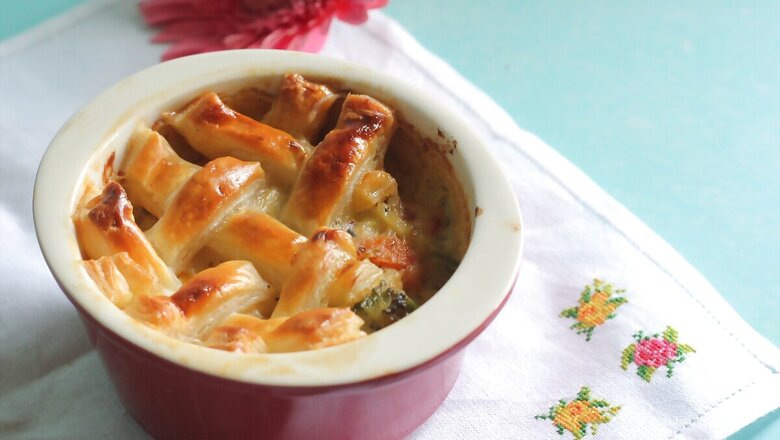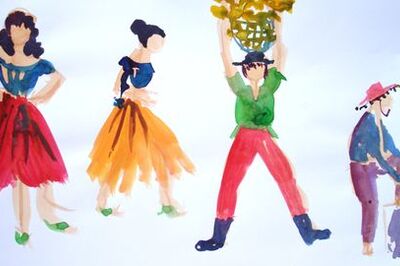
views
She’d roll out white pastry dough and line a round pan and bake it blind till it formed a biscuity shell. Blind baking is when you bake a pie crust or the pastry without the filling, because what you’re planning to fill the tart or pastry with may not require cooking or baking. Like a lemon curd filling in a Lemon Tart. Once the pastry was baked and ready, she would start making the lemon curd. Lemon curd is made with lemon, love and sugar. Beaten egg yolks, sugar, butter, lemon juice and lemon zest are gently cooked together on a double boiler until thick and then allowed to cool. I don’t know why they call it ‘curd’ because it’s more of soft, smooth, thick custard. When everything cools, this lemon curd is poured into the pastry shell and allowed to chill. For me there is no dessert that can compare with a well-made traditional Lemon Tart, maybe with soft meringue. I could break into a jog or even climb a tree for a large slice.
The earliest known dish that sort of resembles a pie goes all the way back to 9500 BCE and 2000 BCE, within sight of the Neolithic period in ancient Egypt. This ancient Egyptian Pie was probably made out of barley, oats or rye and was possibly filled with honey, so say hieroglyphic pictures that appear on the walls of the tomb of Ramses II, which depict recipes of pies. Imagine. Classic meat pie recipes have also been found carved in hieroglyphs on ancient tablets.
Falling in Love with Pies
A pie is a dish made by lining a container with pastry and filling the container with either a sweet or savoury filling. The filling could be custard, a stewed fruit, or a mixture of cheese and vegetable and meats or mince. A top crust cover is sometimes added to close the container, and the pie is baked until the crust is crisp and the filling is cooked through.
In medieval Britain, pie shells or crust were used purely for the intention of preserving the meat or food inside, and not actually for eating. That’s why the crust was made incredibly thick so that it could withstand being baked over a fire for several hours and the food inside could be preserved for longer. And it is in Britain and France that pastry, pie and tart-making turned into a delicious art. In Britain, meat, game and fish, steak and kidney, pork, game, veal and ham, and poultry pies have been staple dishes since the Middle Ages; the most conspicuous one being the Steak and Ale or Steak and Kidney Pie.
The French have claimed ownership to the Quiche, although it has German origins. The Classic Quiche Lorraine is an open pie with a filling of egg, heavy cream and Gruyère Cheese. If you add onions you have Quiche Alsacienne, if you add spinach you have a Quiche Florentine, and the possibilities are endless. A dish that the colonisers took overseas to America, and is now considered an emotional symbol of American tradition and patriotism, is the Apple Tart or Tarte Tatin aux Pommes, imagined to have been the result of a “sweet mistake”, when the Tatin sisters in a small town in France’s Loire Valley bungled up a recipe and stumbled upon caramelised fruit over a crisp pastry crust and created the “Tarte”.
While you can get fruit or chocolate tarts in most patisseries and cake shops, a good savoury pie is hard to find. My friend Subashree Basu has been making pies for the longest time at her Hungry Cat Kitchen. And she has quite a repertoire of pies. She does a mean Raised Pork Pie (or Yorkshire Pie) which is a Brit delicacy, the bestseller, a Classic Pork Pot Pie (slow cooked pork with green apples, celery and cranberry, topped with puff pastry), my favourite, Ham and Cheese Pot Pie (chopped ham with cheese and herbs topped with puff pastry), and then let’s her creativity loose with a Parsi Salli Boti Pie, Butter Chicken Pot Pie, and Bengali Kosha Mangsho Pie. And, she also does puffs. Ham and Cheese Puffs, Chicken Puffs and Goan Chouriço Puffs.
The Hot, Soft-hearted Puff
Oh my god puffs. Those hot, crusty and flaky baked patties. They were my favourite and still are. Puffs are made from puff pastry, which is a thin-layered flaky pastry made by repeatedly folding and rolling thin sheets of dough separated with butter in between. When this puff pastry is gently filled with a spicy mince or chicken in white sauce, pork sausage or ham and cheese, the sheets folded over and baked till golden brown, the end result is nothing short of ecstasy, euphoria and rapture.
Puffs were popularized by Irani and Christian bakeries of Bombay, and are still quite popular snacks. Golden puff pastry, stuffed with chicken and béchamel, from Candies in Bandra or Plate & Pint at Warden Road are my absolute favourite. Candies also makes warm rolls of gentle puff layers curling around a small pink sausage, available only after noon. Big fat and airy mutton mince patties flavoured with turmeric and red chilly that till today come hot out of the ovens of Original Persian Bakery & Stores at Grant Road and get over within minutes of them being displayed in their heated glass cabinets. Oh that warm nutty butter taste that is combined with frail and sheer layers of toasty flakiness.
Straight out of the oven, the hot, soft-hearted puff is gentle enough to buckle into a shower of small crumbs on your first bite, revealing the piping hot soufflé of chicken or the warmed-up ham and melting cheddar or the masala of kheema hidden inside. And when you’re done, everyone knows you’ve had a snack of ‘patties’ because the tell-tale flakes of pastry will unbashedly be all over your chin and on the front of your shirt.
Read all the Latest News, Breaking News and Coronavirus News here. Follow us on Facebook, Twitter and Telegram.




















Comments
0 comment